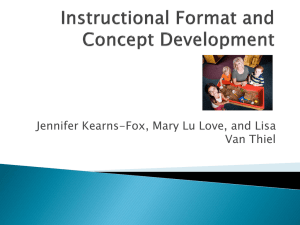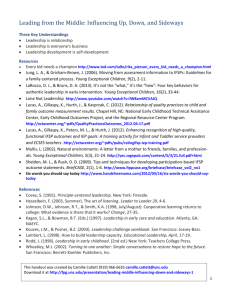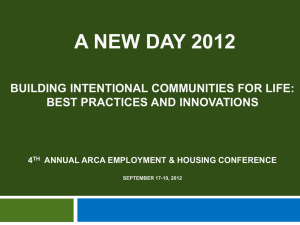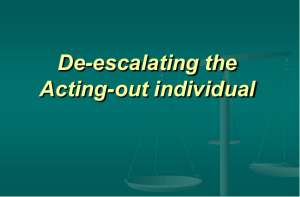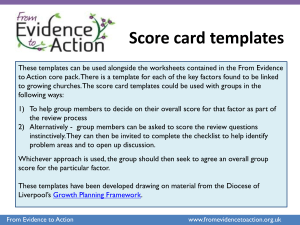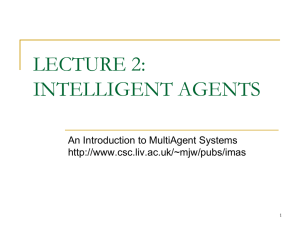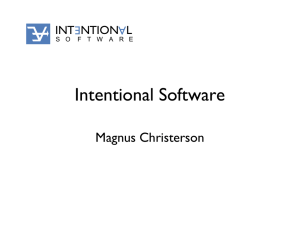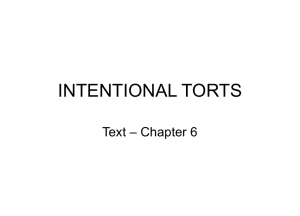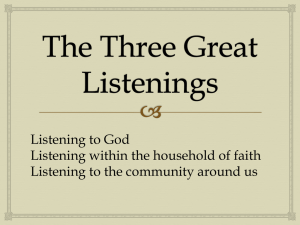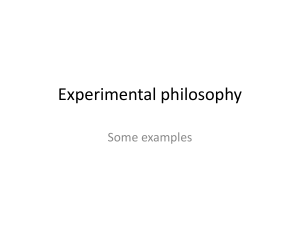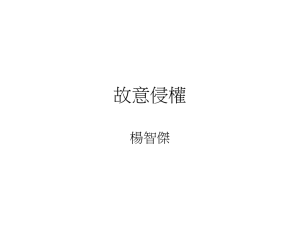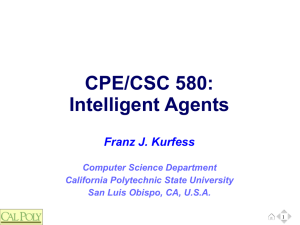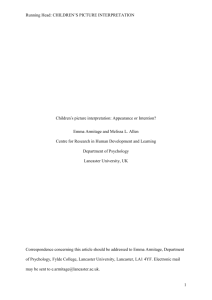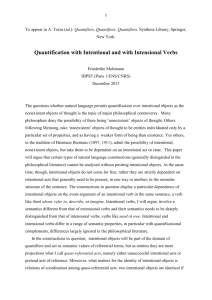The Intentional Teacher
advertisement
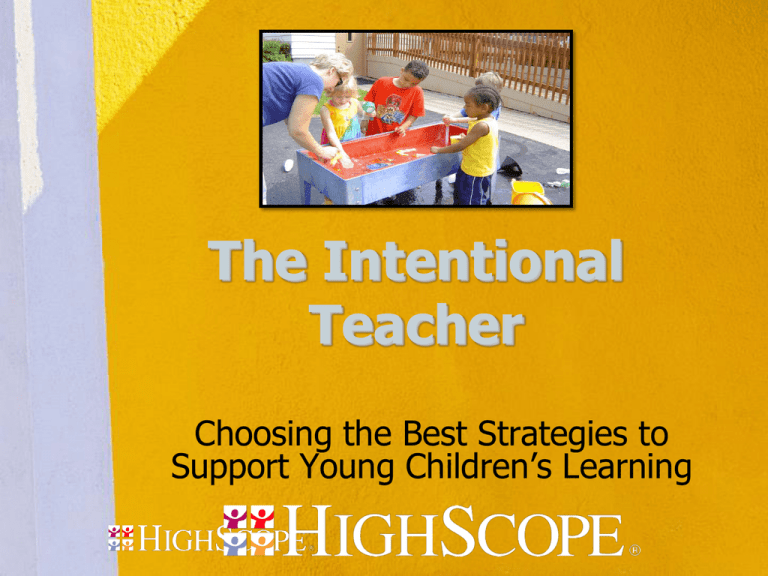
The Intentional Teacher Choosing the Best Strategies to Support Young Children’s Learning Morning Objectives Participants will be able to: • Define the term Intentional Teacher • Explain the difference between adultguided & child-guided learning. • Describe best intentional teaching practices. 2 Guess Who’s Coming to Dinner? You’ve just found out that Oprah Winfrey has selected your home to be featured on her show. She’s coming to dinner tomorrow and it will be taped for her show. You have 15 minutes to plan the menu. What’s for dinner? 3 Guess Who’s Coming to Dinner? You’ve just come home late from a very long, hard day at work. Your kids are at their grandparents, your spouse is away on a business trip and it’s just you to cook for. What’s for dinner? 4 What was the difference in the two meal planning activities? Which meal planning activity was intentional? What does it mean to be intentional?? 5 What does it mean to be an Intentional Teacher? In your table groups, come up with a working definition of the above term that you all agree on. Write it on your chart paper and post it in the room. 6 Components of an Intentional Teacher..... • One who acts with specific outcomes or goals in mind for children’s learning. • One who integrates and promotes meaningful learning in both academic & traditional domains . • One who uses strategies that purposefully challenges, scaffolds and extends children’s learning. • One who understands, both child-guided & adultguided experiences are important in early childhood settings. 7 Content Vocabulary Concepts Skills 8 Child–guided / Adult-guided • Proceeds primarily along the lines of children’s interests and actions, with strategic teacher support. • Proceeds primarily along the lines of the teacher's goal, but is also shaped by the children’s active engagement. • It is NOT entirely child controlled with the teacher being passive. • It is NOT entirely adult controlled with the children being passive. 9 Intentional Teaching • Regardless of the content evident in the play, there are times to choose between adultguided and child-guided strategies. 10 What do Intentional Teachers Do? In your table groups, decide which situation proceeds along the lines of Supporting Child-Guided Experiences or Employing Adult-Guided Experiences 11 Check Your Work The Intentional Teacher (page 129) Can you think of some examples in your own classrooms of when to support child-guided experiences? Can you think of some examples in your classrooms of when you can employ adultguided experiences? 12 Content-Dependent Intentional Teaching • There is some content that primarily emerges from child-guided experiences and from adult-guided experiences. 13 What Do Intentional Teachers Do? Working in table groups, for each example in your handout, decide: • Whether children learn primarily through child-guided or adult-guided experiences. • Why learning proceeds in this way. • What intentional teachers can do to promote learning these concepts and skills. 14 Answers A= Adult-guided C= Child-guided 1 A 9 C 2 C 10 C 3 A 11 A 4 C 12 C 5 A 13 A 6 C 14 C 7 A 15 A 8 C 15 New Definition of Intentional Teaching • Knowing what situation calls for child-guided or adult-guided strategies. • Knowing what content (vocabulary, concepts, and skills) is learned primarily through childguided or through adult-guided experiences. • Thoughtfully providing the appropriate scaffolding that promotes both types of learning in all situations and content areas. 16 What are “Best Practices” Principles? • Structuring the Physical Environment • Building relationships with Families • Scheduling the Program day • Assessing children’s development • Interacting with children Considering and using these best practices will help administrators and teachers create an early childhood program in which adults and children are partners in the learning process. 17 What do you Know about Best Practice? • With your group, move around the room, recording everything you know about the five best practices principles on the chart paper. 18 Reviewing “Best Practices” Principles Structuring the physical learning environment: • Provide a safe & healthy indoor & outdoor environment. • Organize the space in interest areas or centers. • Supply plentiful and diverse equipment & materials. • Display work created by and of interest to children. 19 Reviewing “Best Practices” Principles Scheduling the program day: • Establish a consistent yet a flexible daily routine • Allow for a variety of types of activities • Use a variety of groupings (individual, small, and large group) • Allow just enough time for each type of activity 20 Reviewing “Best Practices” Principles Interacting with children: • Meet basic physical needs. • Create a warm & caring atmosphere. • Encourage & support language & communication. • Encourage initiative. • Introduce information and model skills. • Acknowledge children’s activities & accomplishments. • Support peer interactions. • Encourage independent problem solving. 21 Reviewing “Best Practices” Principles Building relationships with families • Exchange information about the curriculum and how it promotes children’s development. • Provide information about how to extend learning at home. 22 Reviewing “Best Practices” Principles Assessing children’s development: • Use assessment results to plan for individual children and the whole group as a whole. • Use assessment results to identify areas for professional development. 23 Putting It All Together • Best Practices & Intentional Teaching work.. They work in synergy. Synergy can be defined as the interaction of two or more agents or forces so that their combined effect is greater than the sum of their individual effects. 24 Putting It All Together The mission of the Intentional Teacher is to ensure that children acquire the knowledge & skills they need in school and in life. To fulfill this mission, intentional teachers conscientiously address every area of early learning. 25 Thinking about My Practice Find a partner from another table. • Talk to each other about one content area where you will be providing support that is more adult-guided than you have practiced before, and your rationale for doing so. • Discuss one area of Best Practice that you would like to improve upon. • Discuss one area of Best Practice where you feel you are doing well. 26 Adult-guided Applying it to HighScope Creative Physical Creative Represenation SocialEmotional Intellectual Music & Movement Initiative, Social Relations Language & Literacy, Mathematics and Science 27 Child-guided Implementation Plan Think about what we discussed this morning. Record thoughts about each topic in the appropriate square. Supporting child-guided learning experiences Supporting adult-guided learning experiences Implementing best practices What I can do to become a more Intentional Teacher 28
